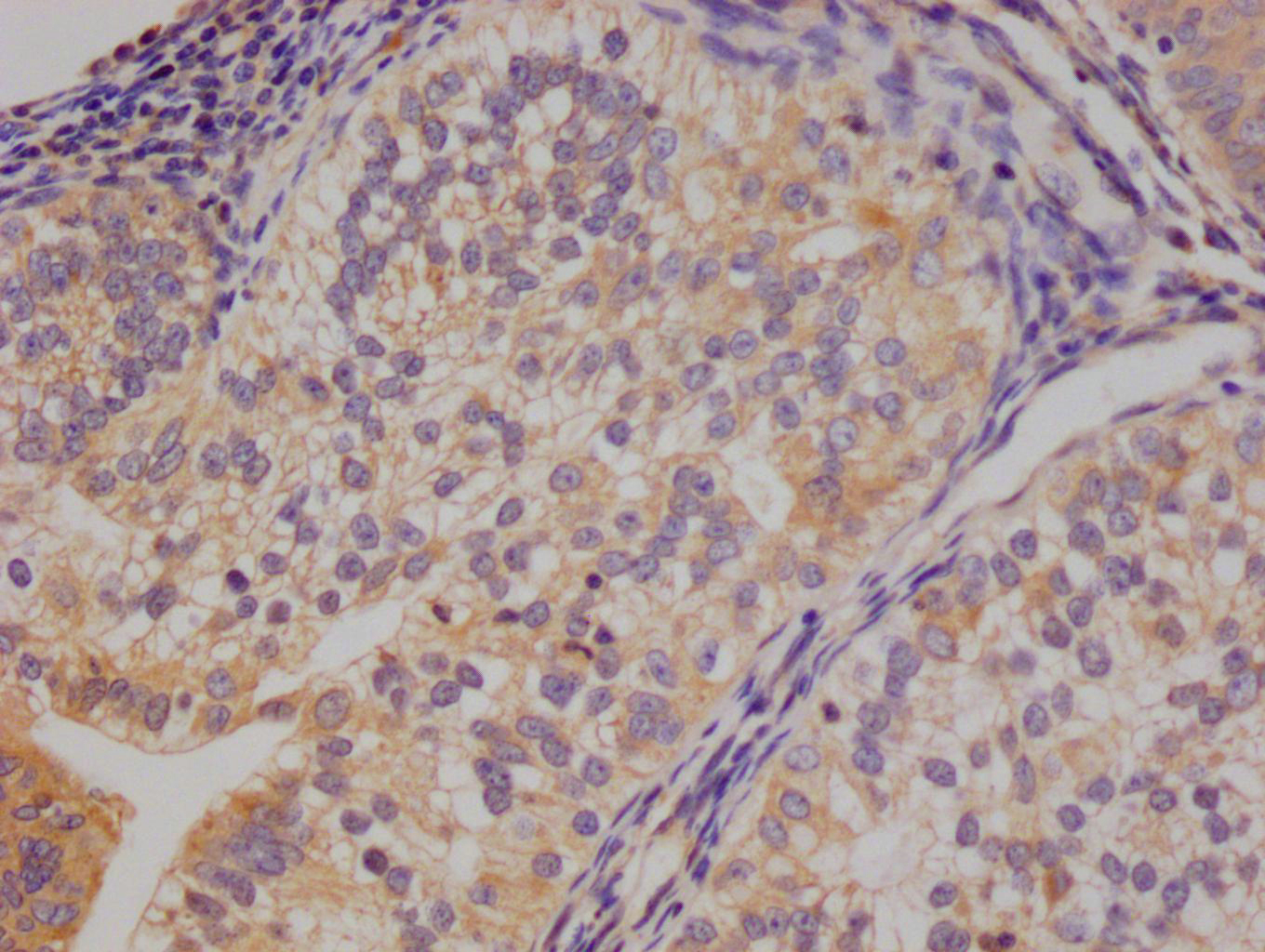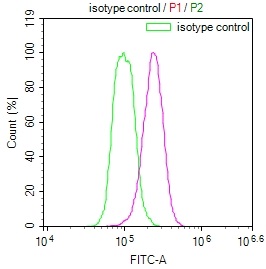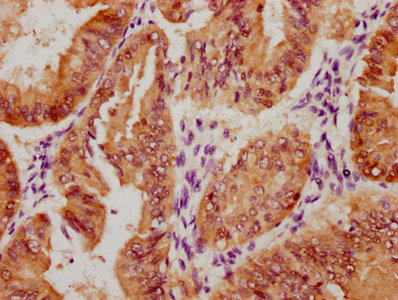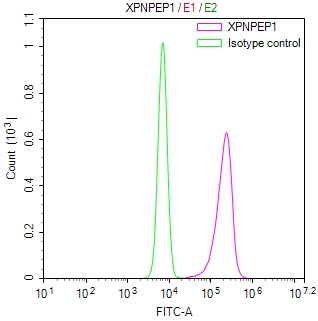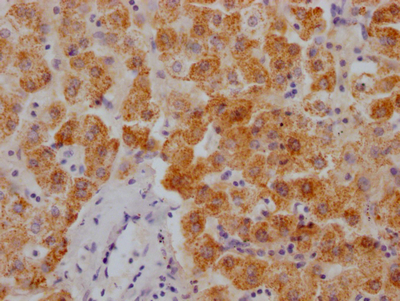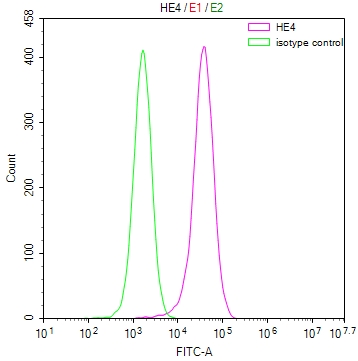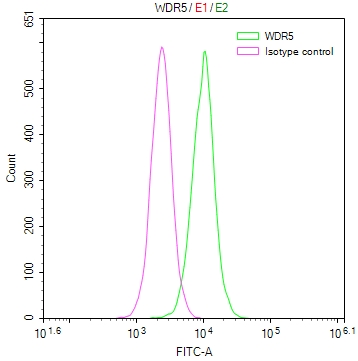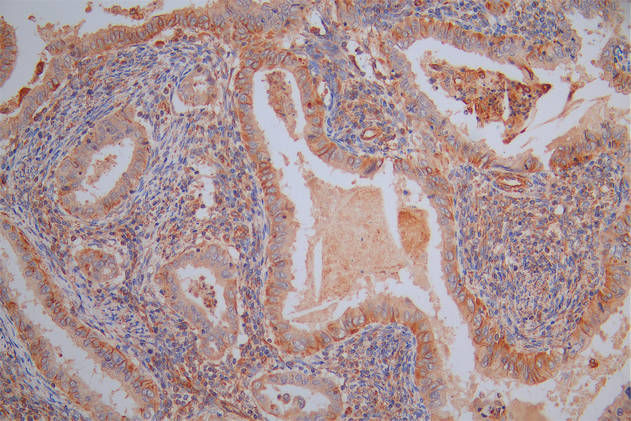-
中文名稱:PRAME兔多克隆抗體, FITC偶聯
-
貨號:CSB-PA018603LC01HU
-
規格:¥880
-
其他:
產品詳情
-
產品名稱:Rabbit anti-Homo sapiens (Human) PRAME Polyclonal antibody
-
Uniprot No.:
-
基因名:
-
別名:4930534P07Rik antibody; Cancer/testis antigen 130 antibody; CT130 antibody; MAPE antibody; Melanoma antigen preferentially expressed in tumors antibody; OIP 4 antibody; OIP-4 antibody; OIP4 antibody; OPA interacting protein 4 antibody; Opa interacting protein OIP4 antibody; OPA-interacting protein 4 antibody; PRAME antibody; PRAME_HUMAN antibody; Preferentially expressed antigen in melanoma antibody; Preferentially expressed antigen of melanoma antibody; RP23-250F8.3 antibody
-
宿主:Rabbit
-
反應種屬:Human
-
免疫原:Recombinant Human Melanoma antigen preferentially expressed in tumors protein (1-509AA)
-
免疫原種屬:Homo sapiens (Human)
-
標記方式:FITC
-
克隆類型:Polyclonal
-
抗體亞型:IgG
-
純化方式:>95%, Protein G purified
-
濃度:It differs from different batches. Please contact us to confirm it.
-
保存緩沖液:Preservative: 0.03% Proclin 300
Constituents: 50% Glycerol, 0.01M PBS, PH 7.4 -
產品提供形式:Liquid
-
儲存條件:Upon receipt, store at -20°C or -80°C. Avoid repeated freeze.
-
貨期:Basically, we can dispatch the products out in 1-3 working days after receiving your orders. Delivery time maybe differs from different purchasing way or location, please kindly consult your local distributors for specific delivery time.
-
用途:For Research Use Only. Not for use in diagnostic or therapeutic procedures.
相關產品
靶點詳情
-
功能:Substrate-recognition component of a Cul2-RING (CRL2) E3 ubiquitin-protein ligase complex, which mediates ubiquitination of target proteins, leading to their degradation. The CRL2(PRAME) complex mediates ubiquitination and degradation of truncated MSRB1/SEPX1 selenoproteins produced by failed UGA/Sec decoding. In the nucleus, the CRL2(PRAME) complex is recruited to epigenetically and transcriptionally active promoter regions bound by nuclear transcription factor Y (NFY) and probably plays a role in chromstin regulation. Functions as a transcriptional repressor, inhibiting the signaling of retinoic acid through the retinoic acid receptors RARA, RARB and RARG: prevents retinoic acid-induced cell proliferation arrest, differentiation and apoptosis.
-
基因功能參考文獻:
- Knockdown PRAME in HCC cells, increased cell apoptosis was correlated with the proportion of cells in G0/G1 stage, activated p53 mediated apoptosis, and increased cyclin p21 expression. PMID: 29439259
- PRAME is frequently expressed in epithelial ovarian cancer at the mRNA and protein levels, and DNA methylation is a key mechanism regulating its expression. PMID: 27322684
- PRAME is aberrantly hypomethylated and activated in Class 1 and Class 2 uveal melanomas and is associated with increased metastatic risk in both classes PMID: 27486988
- To investigate the impact of gene copy number variation on PRAME expression, plasma cells were sorted from 50 newly diagnosed multiple myeloma patients and 8 healthy volunteers to measure PRAME transcript levels and gene copy numbers by real-time quantitative polymerase chain reaction. PMID: 28953414
- Tumor antigen PRAME is up-regulated by MZF1 in cooperation with DNA hypomethylation in melanoma cells. PMID: 28634046
- Results support the potential utility of NY-ESO-1, PRAME, and MAGEA4 as targets for immunotherapy and as ancillary prognostic parameters in synovial sarcomas. PMID: 27993576
- PRAME plays a role in preventing the invasion and metastasis of lung adenocarcinoma PMID: 27391090
- PRAME is expressed in many primary and metastatic UMs, and about half of the metastatic UMs coexpress PRAME and HLA class I. PMID: 28448663
- PRAME is a downstream factor of SOX17 and LIN28 in regulating pluripotency and suppressing somatic/germ cell differentiation in primordial germ cells, germ cell neoplasia in situ, and seminomas. PMID: 27441500
- In line with its roles in controlling cell growth, RPAME regulates multiple critical cell-growth related genes, including IGF1R oncogene. IGF1R up-regulation contributes to increase of cell growth upon the knockdown of PRAME. PMID: 27241212
- This study demonstrates that PRAME functions as a tumor suppressor in breast cancer. PMID: 27632898
- PRAME is an independent prognostic biomarker in Uveal melanoma , which identifies increased metastatic risk in patients with Class 1 or disomy 3 tumors. PMID: 26933176
- Leukemias expressing high levels of PRAME had higher levels of cell death by regulating S100A4/p53 signaling. PMID: 27049257
- Our results suggest that the leukemias expressing high levels of PRAME has favorable prognosis PMID: 26823776
- PRAME expression is considered as a poor prognostic parameter in HL. PMID: 26044287
- PRAME immunoreactivity in myeloid leukemia (ML) of Down syndrome (DS) is largely due to the non-blast components, while PRAME immunoreactivity in blasts of Transient abnormal myelopoiesis (TAM) is not restricted to cases that progress to ML of DS. PMID: 25887863
- This study shows the prognostic significance of PRAME expression in diffuse large B-cell lymphoma patients treated with R-CHOP therapy. PMID: 24820636
- results suggested that PRAME was a predictor for better outcome, could be a useful target for immunotherapy, and might represent a candidate marker for the monitoring of minimal residual disease PMID: 24600975
- elevated PRAME expression in head and neck squamous cell carcinoma PMID: 23905893
- PRAME and WT1 transcripts constitute a good molecular marker combination for monitoring minimal residual disease in MDS. PMID: 23110703
- PRAME impairs differentiation and increases proliferation likely via blocking retinoic acid receptor signaling. PMID: 23444226
- PRAME is upregulated by signalling pathways that are activated in response to infection/inflammation. PMID: 23460923
- The complex PRAME/EZH2 is able to repress TRAIL expression, in a cancer-specific manner; inhibition of PRAME/EZH2 releases apoptosis-mediating TRAIL. (Review) PMID: 23228130
- PRAME and its paralogs are leucine rich repeat proteins. Structure predictions suggest PRAME resembles the extracellular domains of TLR3 and TLR4, or intracellular NALP family. This suggests PRAME may have a role in sensing Pathogen Associated Molecular Patterns (PAMPs). PMID: 23460923
- PRAME expression in leukaemic cell lines is upregulated by IFN gamma and LPS, suggesting a possible role in immune responses. PRAME associates with Elongin BC complexes by binding Elongin C, and co-localises to the Golgi network. Nuclear PRAME interacts with Histone H3. The results suggest that PRAME has dual roles in gene regulation in the nucleus and protein turnover trafficking in the Golgi PMID: 23460923
- Knock-down of PRAME increases retinoic acid signaling and cytotoxic drug sensitivity of Hodgkin lymphoma cells. PMID: 23409080
- a novel link between the oncoprotein PRAME and the conserved EKC complex PMID: 22912744
- PRAME as biomarkers for solid tumor PMID: 23075240
- NYESO-1/LAGE-1s and PRAME are targets for antigen specific T cells in chondrosarcoma following treatment with 5-Aza-2-deoxycitabine PMID: 22384167
- PRAME expression is regulated at the epigenetic level. For this reason inhibitors of DNA methylation, such as 5-azacytidine, can modulate the expression of this tumor associated antigen. PMID: 22503131
- Studies suggest that activated human gammadelta T cells can efficiently present PRAME and STEAP1-derived epitopes and allow breaking tolerance against these tumor-associated self-antigens. PMID: 21928126
- these results suggest that PRAME plays an important role in cell proliferation and disease progression in osteosarcoma. PMID: 22390931
- the expansion of the PRAME family occurred in both autosomes and sex chromosomes PMID: 21347312
- PRAME effectively differentiates mullerian carcinoma from malignant mesothelioma at the mRNA and protein levels. PMID: 22261449
- PRAME expression might be related to distinct patterns of tumorigenesis PMID: 21691740
- PRAME plays an important role in disease progression in acute leukemia. PMID: 21550659
- The authors applied protein-complex purification strategies and identified PRAME as a substrate recognition subunit of a Cullin2-based E3 ubiquitin ligase. PMID: 21822215
- The level of prame gene transcript increases in chronic myeloid leukemia which associates with disease progression. PMID: 20723287
- The cytotoxic activity of our PRAME-specific CTLs was directed not only against leukemic blasts, but also against leukemic progenitor cells as assessed by colony-forming-inhibition assays, which have been implicated in leukemia relapse. PMID: 21278353
- PRAME may be involved in the tumorigenic process in a wide range of cancers, at least in part by blocking the tumor suppressor pathway mediated by TRAIL expression. PMID: 20838376
- Results showed the expression of MCSP and PRAME in conjunctival melanoma and benign conjunctival nevi and showed that MCSP and PRAME were differentially expressed in both and can help to differentiate the lesions diagnostically. PMID: 20805128
- The PRAME transcript was highly expressed in acute myeloid leukemia patients and was a favorable marker of prognosis. PMID: 20376794
- PRAME mRNA could be used to monitor minimal residual disease in newly diagnosed acute myeloid leukemia patients. PMID: 19035174
- E2F4, PHACTR3, PRAME family member and CDH12 most probably play important role in non-small-cell lung cancer geneses PMID: 19473719
- expression of PRAME is an indicator of favorable prognosis and could be a useful tool for monitoring minimal residual disease in childhood AML. PMID: 11943337
- PRAME gene expression in childhood acute lymphoblastic leukemia PMID: 12419593
- PRAME is highly expressed in primary advanced neuroblastoma PMID: 15240516
- The overexpression of PRAME protein frequently observed in human cancers confers growth or survival advantages by antagonizing retinoic acid receptor(RAR) signaling. PMID: 16179254
- The results suggest that the analysis of PRAME protein may contribute for the distinction between normal and leukemic cells in chronic lymphoproliferative disorders(CLD), and that PRAME may be a potential target for therapy. PMID: 16620968
- PRAME is expressed in acute myeloblastic leukaemia PMID: 16681423
顯示更多
收起更多
-
亞細胞定位:Nucleus. Chromosome. Cytoplasm. Golgi apparatus. Cell membrane.
-
蛋白家族:PRAME family
-
組織特異性:Expressed in testis. Detected in samples of kidney, brain and skin.
-
數據庫鏈接:
Most popular with customers
-
-
YWHAB Recombinant Monoclonal Antibody
Applications: ELISA, WB, IHC, IF, FC
Species Reactivity: Human, Mouse, Rat
-
Phospho-YAP1 (S127) Recombinant Monoclonal Antibody
Applications: ELISA, WB, IHC
Species Reactivity: Human
-
-
-
-
-


